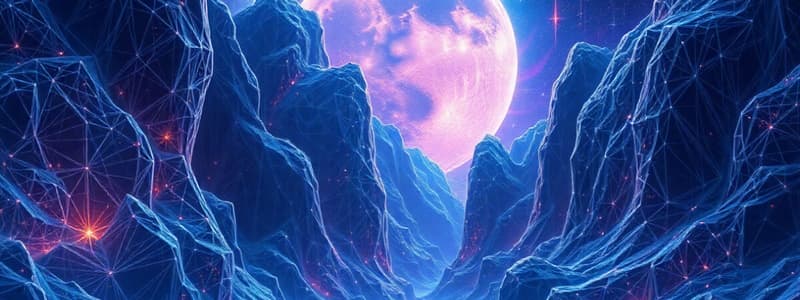Podcast
Questions and Answers
What is a primary application of Generative Adversarial Networks (GANs)?
What is a primary application of Generative Adversarial Networks (GANs)?
- Text Summarization
- Image Resolution Reduction
- Audio Noise Reduction
- Face Aging Simulation (correct)
Which of the following is NOT a typical use case for Convolutional Neural Networks (CNNs)?
Which of the following is NOT a typical use case for Convolutional Neural Networks (CNNs)?
- Photograph Editing Techniques
- Image Classification
- Text Generation (correct)
- Medical Image Analysis
In which application would feature extraction using an image kernel be most relevant?
In which application would feature extraction using an image kernel be most relevant?
- Creating Cartoon Characters (correct)
- Natural Language Processing
- Data Encryption
- Audio Signal Processing
What is a common application of Autoencoders in generative AI?
What is a common application of Autoencoders in generative AI?
Which deep learning model would likely be used for generating realistic facial images?
Which deep learning model would likely be used for generating realistic facial images?
What is one of the applications of GANs in relation to cartoon characters?
What is one of the applications of GANs in relation to cartoon characters?
How can GANs be applied to photograph editing?
How can GANs be applied to photograph editing?
What capability of GANs allows users to visualize how they might look over time?
What capability of GANs allows users to visualize how they might look over time?
What is a key characteristic of an autoencoder?
What is a key characteristic of an autoencoder?
Which application is specifically related to dimensionality reduction in autoencoders?
Which application is specifically related to dimensionality reduction in autoencoders?
What is one way autoencoders can contribute to image processing?
What is one way autoencoders can contribute to image processing?
Which type of autoencoder can be used for anomaly detection?
Which type of autoencoder can be used for anomaly detection?
What is a primary function of GANs in the context of face generation?
What is a primary function of GANs in the context of face generation?
What are the two main components of a Generative Adversarial Network (GAN)?
What are the two main components of a Generative Adversarial Network (GAN)?
What is a primary application of GANs in the field of image generation?
What is a primary application of GANs in the field of image generation?
How does the generator in a GAN improve its performance?
How does the generator in a GAN improve its performance?
What role does the discriminator play in a GAN?
What role does the discriminator play in a GAN?
When training a GAN, what does the discriminator's loss function penalize?
When training a GAN, what does the discriminator's loss function penalize?
What do GANs primarily strive to achieve in a competitive environment?
What do GANs primarily strive to achieve in a competitive environment?
Which of the following is NOT a typical application of GANs?
Which of the following is NOT a typical application of GANs?
What could be a potential use of GAN-generated images in digital platforms?
What could be a potential use of GAN-generated images in digital platforms?
Flashcards are hidden until you start studying
Study Notes
Generative Adversarial Network (GAN)
- GANs are comprised of two neural networks: a generator and a discriminator.
- The generator learns to produce plausible data, which acts as negative training examples for the discriminator.
- The discriminator learns to differentiate between real data and fake data generated by the generator.
- GAN training involves simultaneous training of the generator and discriminator with opposing objectives.
Autoencoder
- Autoencoders are a type of unsupervised deep learning network.
- They consist of an encoder and decoder, both of which are neural networks.
- The encoder compresses the input into a lower-dimensional latent representation, while the decoder reconstructs the input from the latent representation.
- Autoencoders are trained to replicate their input to their output, effectively learning a compressed representation of the input data.
Applications of GANs
- GANs can create realistic photographs of faces, including images of people who don't exist.
- These images can be used for tasks such as creating avatars or social media profiles.
- GANs can generate cartoon characters similar to those found in popular movies or TV shows.
- The generated characters can be used to create new content or customize existing characters in games and other applications.
- GANs can be used to edit photographs by altering backgrounds, adding or removing objects, or changing the appearance of people or animals.
- GANs can simulate how a person might age by generating images of them at different ages.
Applications of Autoencoders
- Autoencoders can be used for dimensionality reduction, particularly undercomplete autoencoders.
- Denoising autoencoders can effectively remove noise from images.
- Variational autoencoders can generate both image and time series data.
- Undercomplete autoencoders can detect anomalies.
Convolutional Neural Network (CNN)
- CNNs are ideal for processing structured grid data, such as images.
- CNNs utilize convolutional layers to learn spatially invariant features.
- Image kernels, small matrices used in image processing, are used in CNNs for feature extraction.
- These kernels identify key features in an image by applying effects like blurring, sharpening, outlining, and embossing.
Studying That Suits You
Use AI to generate personalized quizzes and flashcards to suit your learning preferences.




